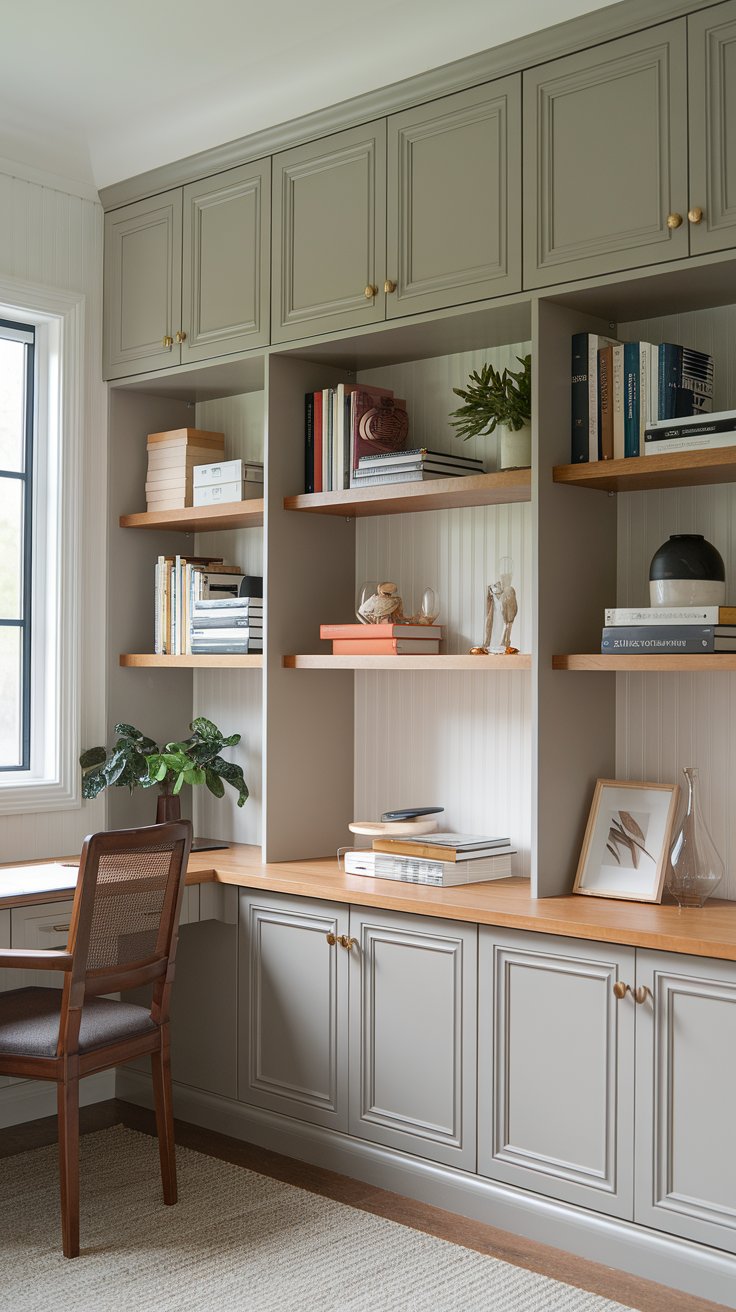Built-in storage is a hallmark of functional and stylish home design. Whether you’re planning for a living room, kitchen, or home office, the choice between open shelving, closed cabinets, or a mix of both can greatly influence the look and practicality of your space. This comprehensive guide explores the pros, cons, and best uses of each option, helping you create a built-in system that meets your needs and complements your interior design style.

The Case for Open Shelving
Open shelving is a popular choice for built-ins due to its airy and modern aesthetic. It’s particularly favored in contemporary and minimalist spaces. Here’s why open shelving might be the right fit for your home:
Pros:
- Visual Appeal:
Open shelves create an open, inviting atmosphere. They’re ideal for displaying decorative items, books, or curated collections, adding personality to your space. - Accessibility:
Everything is within reach and visible, making it easy to find and grab items without rummaging through closed doors. - Cost-Effectiveness:
Open shelving tends to be more budget-friendly than cabinets, as it uses less material and often requires less labor to install. - Versatility:
You can style open shelves seasonally or change them frequently to refresh the look of your room without major renovations.
Cons:
- Maintenance:
Open shelves can accumulate dust quickly, requiring regular cleaning to keep them tidy. - Cluttered Look:
Without careful organization, open shelves can appear messy or overcrowded, detracting from their aesthetic appeal. - Limited Concealment:
They lack the ability to hide less attractive items, making them less suitable for spaces where function takes precedence over form.

Best Applications:
Open shelving works well in kitchens for displaying plates and glassware, in living rooms for showcasing books and decor, and in bathrooms for storing neatly arranged towels or toiletries.
The Case for Closed Cabinets
Closed cabinets offer a timeless and practical solution for built-ins. They’re often used in traditional, transitional, or industrial designs where functionality and a polished appearance are paramount.
Pros:
- Concealed Storage:
Closed cabinets allow you to hide clutter, mismatched items, or bulky belongings, maintaining a clean and organized look. - Protection:
Cabinets protect stored items from dust, sunlight, and potential damage, making them ideal for delicate or valuable possessions. - Customizability:
Cabinets can be tailored to include internal features like shelves, drawers, and dividers, optimizing storage for specific needs. - Streamlined Aesthetic:
They provide a uniform appearance, creating a cohesive and serene environment.
Cons:
- Cost:
Cabinets are typically more expensive than open shelving due to the materials, hardware, and craftsmanship involved. - Space Constraints:
Closed cabinets can feel bulky or overbearing in smaller spaces, making a room feel cramped. - Limited Display Opportunities:
With everything hidden behind doors, cabinets may lack the decorative flair of open shelving.
Best Applications:
Closed cabinets are ideal for kitchens to store pantry items and appliances, in home offices for concealing documents, and in living rooms for stashing games, electronics, or DVDs.

The Case for a Mix of Both
Combining open shelving and closed cabinets provides the best of both worlds. This hybrid approach is becoming increasingly popular as it balances functionality with style.
Pros:
- Aesthetic Flexibility:
A mix allows for both display and concealment, making your built-ins versatile and visually interesting. - Organization:
Open shelves can showcase frequently used or decorative items, while cabinets can house less attractive or seasonal belongings. - Optimized Space:
A hybrid system can be customized to suit your specific needs, maximizing both storage and design potential. - Balanced Look:
Mixing elements adds depth and character, avoiding the monotony of an all-cabinet or all-shelf design.
Cons:
- Complexity in Design:
Planning a combination system can be more challenging, as you need to decide which sections are open and which are closed. - Cost Considerations:
This approach can sometimes be pricier than choosing one option due to the varied materials and design elements.

Best Applications:
In kitchens, open shelves can hold everyday dishes while cabinets conceal larger items. In living rooms, books and decor can adorn open shelves, while cabinets hide cords, remotes, and other essentials.
Factors to Consider When Choosing Built-Ins
- Room Functionality:
Consider how the space will be used. High-traffic or heavily utilized areas might benefit from more closed cabinets for quick tidying, while decorative spaces can lean on open shelving. - Aesthetic Goals:
Your desired design style plays a significant role. Modern and minimalist interiors often favor open shelving, while traditional designs lean toward closed cabinets. - Maintenance:
Be realistic about how much time and effort you’re willing to spend on upkeep. Open shelving requires more frequent cleaning, whereas closed cabinets are low maintenance. - Budget:
Determine how much you’re willing to spend. Open shelving is typically less expensive, but a mix can offer a cost-effective solution if planned wisely. - Room Size:
In smaller rooms, open shelving can create the illusion of space, while closed cabinets can make larger rooms feel more grounded and structured.

Styling Tips for Built-Ins
- For Open Shelving:
- Keep it simple and curated.
- Use matching storage baskets or bins for smaller items.
- Play with varying heights and textures for visual interest.
- For Closed Cabinets:
- Opt for high-quality materials and finishes to enhance their visual appeal.
- Consider soft-close doors for a sleek and quiet experience.
- For a Mix:
- Maintain a cohesive color palette to tie the look together.
- Balance the placement of open and closed sections to avoid a lopsided appearance.
Conclusion
The decision between open shelving, closed cabinets, or a mix of both comes down to personal preference, lifestyle, and the specific needs of your space. Open shelving shines in modern and airy spaces where display is key, while closed cabinets offer practical, concealed storage. A hybrid approach gives you the flexibility to enjoy the benefits of both, making it the perfect solution for many homes.
No matter what you choose, thoughtful design and organization will ensure your built-ins enhance both the style and functionality of your space.







